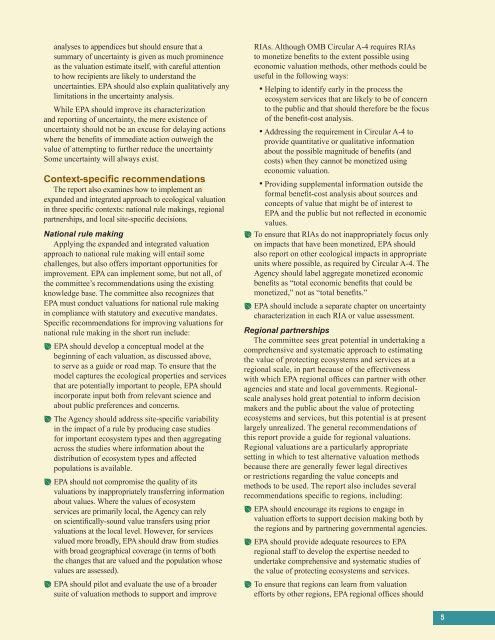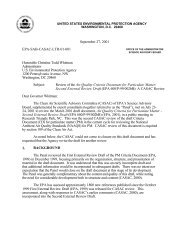Valuing the Protection of Ecological Systems and Services Report
Valuing the Protection of Ecological Systems and Services Report
Valuing the Protection of Ecological Systems and Services Report
Create successful ePaper yourself
Turn your PDF publications into a flip-book with our unique Google optimized e-Paper software.
analyses to appendices but should ensure that a<br />
summary <strong>of</strong> uncertainty is given as much prominence<br />
as <strong>the</strong> valuation estimate itself, with careful attention<br />
to how recipients are likely to underst<strong>and</strong> <strong>the</strong><br />
uncertainties. EPA should also explain qualitatively any<br />
limitations in <strong>the</strong> uncertainty analysis.<br />
While epA should improve its characterization<br />
<strong>and</strong> reporting <strong>of</strong> uncertainty, <strong>the</strong> mere existence <strong>of</strong><br />
uncertainty should not be an excuse for delaying actions<br />
where <strong>the</strong> benefits <strong>of</strong> immediate action outweigh <strong>the</strong><br />
value <strong>of</strong> attempting to fur<strong>the</strong>r reduce <strong>the</strong> uncertainty<br />
Some uncertainty will always exist.<br />
Context-specific recommendations<br />
The report also examines how to implement an<br />
exp<strong>and</strong>ed <strong>and</strong> integrated approach to ecological valuation<br />
in three specific contexts: national rule makings, regional<br />
partnerships, <strong>and</strong> local site-specific decisions.<br />
National rule making<br />
Applying <strong>the</strong> exp<strong>and</strong>ed <strong>and</strong> integrated valuation<br />
approach to national rule making will entail some<br />
challenges, but also <strong>of</strong>fers important opportunities for<br />
improvement. epA can implement some, but not all, <strong>of</strong><br />
<strong>the</strong> committee’s recommendations using <strong>the</strong> existing<br />
knowledge base. The committee also recognizes that<br />
epA must conduct valuations for national rule making<br />
in compliance with statutory <strong>and</strong> executive m<strong>and</strong>ates.<br />
Specific recommendations for improving valuations for<br />
national rule making in <strong>the</strong> short run include:<br />
o epA should develop a conceptual model at <strong>the</strong><br />
beginning <strong>of</strong> each valuation, as discussed above,<br />
to serve as a guide or road map. to ensure that <strong>the</strong><br />
model captures <strong>the</strong> ecological properties <strong>and</strong> services<br />
that are potentially important to people, epA should<br />
incorporate input both from relevant science <strong>and</strong><br />
about public preferences <strong>and</strong> concerns.<br />
o The Agency should address site-specific variability<br />
in <strong>the</strong> impact <strong>of</strong> a rule by producing case studies<br />
for important ecosystem types <strong>and</strong> <strong>the</strong>n aggregating<br />
across <strong>the</strong> studies where information about <strong>the</strong><br />
distribution <strong>of</strong> ecosystem types <strong>and</strong> affected<br />
populations is available.<br />
o EPA should not compromise <strong>the</strong> quality <strong>of</strong> its<br />
valuations by inappropriately transferring information<br />
about values. Where <strong>the</strong> values <strong>of</strong> ecosystem<br />
services are primarily local, <strong>the</strong> Agency can rely<br />
on scientifically-sound value transfers using prior<br />
valuations at <strong>the</strong> local level. However, for services<br />
valued more broadly, EPA should draw from studies<br />
with broad geographical coverage (in terms <strong>of</strong> both<br />
<strong>the</strong> changes that are valued <strong>and</strong> <strong>the</strong> population whose<br />
values are assessed).<br />
o epA should pilot <strong>and</strong> evaluate <strong>the</strong> use <strong>of</strong> a broader<br />
suite <strong>of</strong> valuation methods to support <strong>and</strong> improve<br />
RIAs. Although OMB Circular A-4 requires RIAs<br />
to monetize benefits to <strong>the</strong> extent possible using<br />
economic valuation methods, o<strong>the</strong>r methods could be<br />
useful in <strong>the</strong> following ways:<br />
• helping to identify early in <strong>the</strong> process <strong>the</strong><br />
ecosystem services that are likely to be <strong>of</strong> concern<br />
to <strong>the</strong> public <strong>and</strong> that should <strong>the</strong>refore be <strong>the</strong> focus<br />
<strong>of</strong> <strong>the</strong> benefit-cost analysis.<br />
• Addressing <strong>the</strong> requirement in Circular A-4 to<br />
provide quantitative or qualitative information<br />
about <strong>the</strong> possible magnitude <strong>of</strong> benefits (<strong>and</strong><br />
costs) when <strong>the</strong>y cannot be monetized using<br />
economic valuation.<br />
• providing supplemental information outside <strong>the</strong><br />
formal benefit-cost analysis about sources <strong>and</strong><br />
concepts <strong>of</strong> value that might be <strong>of</strong> interest to<br />
EPA <strong>and</strong> <strong>the</strong> public but not reflected in economic<br />
values.<br />
o to ensure that RiAs do not inappropriately focus only<br />
on impacts that have been monetized, epA should<br />
also report on o<strong>the</strong>r ecological impacts in appropriate<br />
units where possible, as required by Circular A-4. The<br />
Agency should label aggregate monetized economic<br />
benefits as “total economic benefits that could be<br />
monetized,” not as “total benefits.”<br />
o epA should include a separate chapter on uncertainty<br />
characterization in each RiA or value assessment.<br />
Regional partnerships<br />
<strong>the</strong> committee sees great potential in undertaking a<br />
comprehensive <strong>and</strong> systematic approach to estimating<br />
<strong>the</strong> value <strong>of</strong> protecting ecosystems <strong>and</strong> services at a<br />
regional scale, in part because <strong>of</strong> <strong>the</strong> effectiveness<br />
with which EPA regional <strong>of</strong>fices can partner with o<strong>the</strong>r<br />
agencies <strong>and</strong> state <strong>and</strong> local governments. Regionalscale<br />
analyses hold great potential to inform decision<br />
makers <strong>and</strong> <strong>the</strong> public about <strong>the</strong> value <strong>of</strong> protecting<br />
ecosystems <strong>and</strong> services, but this potential is at present<br />
largely unrealized. <strong>the</strong> general recommendations <strong>of</strong><br />
this report provide a guide for regional valuations.<br />
Regional valuations are a particularly appropriate<br />
setting in which to test alternative valuation methods<br />
because <strong>the</strong>re are generally fewer legal directives<br />
or restrictions regarding <strong>the</strong> value concepts <strong>and</strong><br />
methods to be used. <strong>the</strong> report also includes several<br />
recommendations specific to regions, including:<br />
o epA should encourage its regions to engage in<br />
valuation efforts to support decision making both by<br />
<strong>the</strong> regions <strong>and</strong> by partnering governmental agencies.<br />
o EPA should provide adequate resources to EPA<br />
regional staff to develop <strong>the</strong> expertise needed to<br />
undertake comprehensive <strong>and</strong> systematic studies <strong>of</strong><br />
<strong>the</strong> value <strong>of</strong> protecting ecosystems <strong>and</strong> services.<br />
o to ensure that regions can learn from valuation<br />
efforts by o<strong>the</strong>r regions, EPA regional <strong>of</strong>fices should<br />
5

















